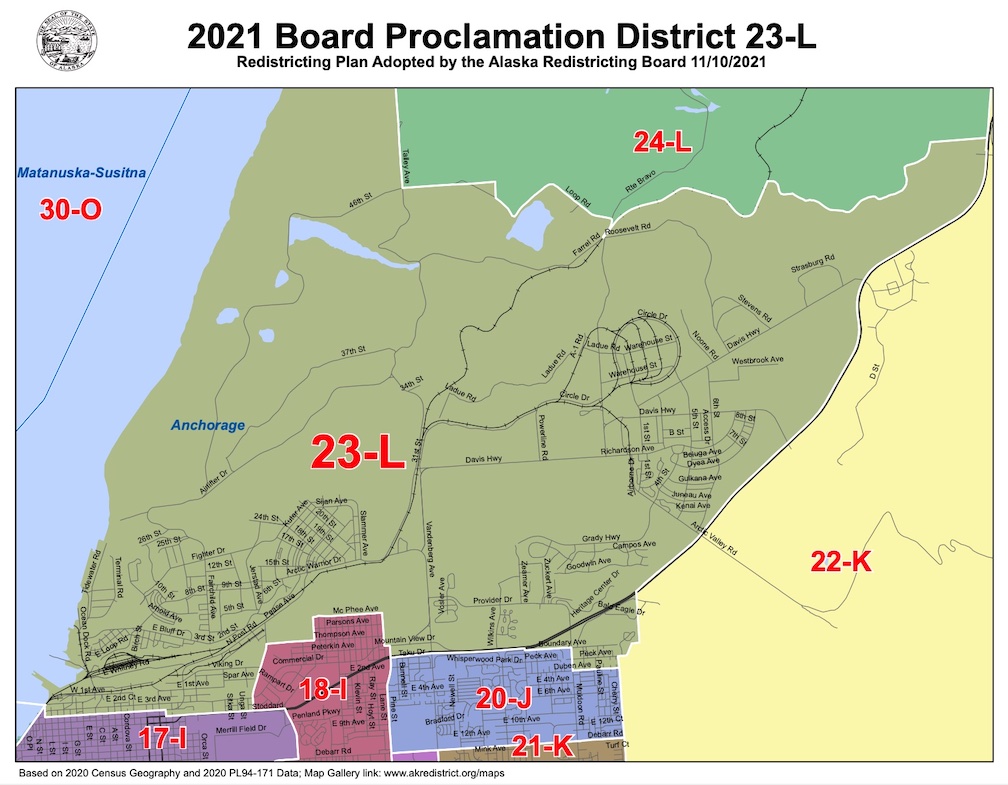Three Anchorage residents filed a lawsuit on Friday challenging the new political district known as Senate Seat L, as drawn by the Alaska Redistricting Board. Their lawsuit objects to having part of East Anchorage lumped in with part of Eagle River, which the plaintiffs call “arbitrary and egregiously irrational senate districts … despite the starkly different and even contradictory legislative needs of those communities. Critically, the pairings inexplicably ignored the demographic, economic and geographic characteristics of these communities and the lack of meaningful contiguity…”
Eagle River is largely white, they say, while East Anchorage is very racially diverse.
Friday was the deadline for lawsuits challenging the new district boundaries to be filed.
The plaintiffs are all part of the new Senate Seat L: Felisa Wilson is a Democrat party activist who lives at an address on JBER. George Martinez is registered nonpartisan who has run for mayor of Anchorage in the past and is described in media as a “prominent Occupy Wall Street activist” from New York. Yarrow Silvers is a nonpartisan voter who is cofounder of a political action group called Anchorage Action, which is a counter to the Save Anchorage grassroots group. The three say that the new map gives Eagle River disproportionate power and lessens the political clout of East Anchorage, when it comes to representation in the Senate.
Another lawsuit was filed by the City of Skagway, which disputes the boundary that puts it in with the north Juneau House district. Skagway maintains that the final version of the map, Version 4, was never made available for public review or comment, in violation of the Open Meetings Act, prior to the last meeting fore presentation of draft plans to the redistricting board.
The plaintiffs in this lawsuit say that Skagway prefers to be aligned with downtown Juneau and Douglas, not the Mendenhall Valley and north, which is physically closer to Skagway. The lawsuit says Skagway wants the map the way it was during the court-approved 2013 redistricting plan.
The City of Valdez filed a lawsuit because its House district was moved in order to align with the Mat-Su, while it says it is economically more aligned with the Richardson Highway pipeline corridor.
Earlier, a lawsuit was filed by the Mat-Su Borough, which said the new map diminished and diluted its growing population. On Friday, a group of Native Corporations joined the suit on the side of the Redistricting Board, saying the map, as now drawn, better keeps Native shareholders in the same district.
The Alaska Redistricting Board has scheduled a meeting on Wednesday, when it will have an executive session to review the lawsuits with the board’s attorney.

Is race, native shareholders, supposed to be a deciding factor in voting district maps?
No, compact districts are, with population numbers being close.
“Eagle River is largely white, they say, while East Anchorage is very racially diverse.”
Funny, no one ever seems to complain when eagle river’s largely white derived tax dollars are used to fund initiatives that do not benefit eagle river. It’s almost as though the plantifs have an issue with being required to associate with whites.
Statewide these districts serve to provide overrepresentation to liberal leaning voters and underrepresentation to conservative leaning voters. When virtually every district in left leaning areas are populated close to the bare minimum allowed while right leaning areas are populated close to the maximum allowed it’s obvious.
And there it is. The race card. Why am I not surprised. This is almost funny. The term “racist” has been so used and over used that it has completely lost its power. What a ridiculous situation.
Perhaps you would benefit from reading the article again, but in case you choose not to (and I’m not counting on you to do so) then I’ll try to explain this as best I can. The word “racist” is not used in this article at any point. I’m assuming that you are referencing the lawsuit filed by the residents of East Anchorage, so I will be addressing that. My apologies if that wasn’t what you were referencing. Nothing in this article even suggests that people involved in the lawsuit have claimed racism as being an issue. The residents of East Anchorage simply think that it is negligent of the Redistricting Board to put two communities in the same district despite clear and significant demographic differences. The residents of Eagle River being white does not mean that they are racists, and I’m certain that the vast majority of them are great people. The same goes for the residents of East Anchorage. However, that doesn’t mean that the state can just ignore a difference of that magnitude. If redistricting is supposed to respond to demographic changes, then certainly this should be taken into account, and East Anchorage and Eagle River should not share a district. I apologize for going on a rant, but I felt like this had to be addressed. Happy Holidays.
Comments are closed.